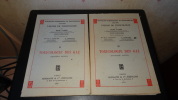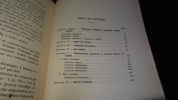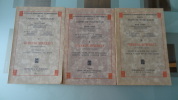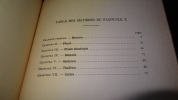-
Type
Autograph (4)
Book (6090)
Magazine (31)
Music sheets (3)
Photographs (8)
-
Latest
Last 24h (4)
Last 3 days (2)
Last month (25)
Last week (1)
-
Language
Czech (1)
English (4)
French (6117)
German (12)
Latin (1)
Spanish (1)
-
Century
17th (22)
18th (223)
19th (1180)
20th (2566)
21st (97)
-
Countries
Belgium (352)
Côte d'Ivoire (14)
Denmark (718)
France (4669)
Switzerland (383)
-
Syndicate
ILAB (3405)
NVVA (194)
SLACES (194)
SLAM (2462)
SNCAO (49)
TOXICOLOGIE DES GAZ
Paris; Hermann & Cie, éditeurs, Actualités Scientifiques et Industrielles, Leçons de Toxicologie n°II & III, 2 volumes brochés de format 25,5 x 16,5 cm, 127 + 147 pages, très bon état. Frais de port en supplément.
Envoi en lettre verte ou par Mondial Relay
TOXIQUES MINÉRAUX
Paris; Hermann & Cie, éditeurs, Actualités Scientifiques et Industrielles, Leçons de Toxicologie n°IX, X & XI, 3 volumes brochés de format 25,5 x 16,5 cm, 104 + 107 + 123 pages, très bon état. Frais de port en supplément.
Envoi en lettre verte ou par Mondial Relay
ÉLÉMENTS D'ÉLECTRICITÉ / LES COURANTS ALTERNATIFS.
Paris, Armand Colin, 1921-1925. Deux volumes in-12, reliés en un, figures.
[6855]
DOCUMENTS POUR DES TRAVAUX PRATIQUES DES GRANULOMETRIE / FEVRIER 1969 / ANNALES DU CRDP.
CRDP - POITIERS. 1969. In-4. Broché. Etat d'usage, Couv. partiel. décollorée, Dos satisfaisant, Intérieur acceptable. 80 pages agraffées et illustrées de nombreux graphiques et figures - Marques de scotch sur le haut du 1er plat.. . . . Classification Dewey : 540-Chimie et sciences connexes
Classification Dewey : 540-Chimie et sciences connexes
Traité élémentaire de chimie, rédigé d'après le nouveau programme adopté par l'université pour les écoles normales.
Paris, Jules Delalain et Cie, 1838. In-12 de VI et 140 pages; une planche dépliante in-fine comportant six figures. Très bon état intérieur. Veau vert de l'époque, roulette dorée sur les plats, dos à nerfs bien orné, tranches marbrées.(Boucart relieur à Rochefort). Dos passé mais bon état.
J. de Fages était professeur de mathématiques, auteur également d'un traité élémentaire de physique et de mécanique.
Guide élémentaire pour l'emploi des engrais chimiques.
Mézières, Imprimerie A. Rousin, 1887, petit in 12, 178 pages, relié plein veau tabac, dos lisse.
PHOTOS sur DEMANDE. ...................... Photos sur demande ..........................


Phone number : 04 77 32 63 69
La Chimie Amusante. - Expériences a la portée de tous.- Ouvrage illustré de 154 gravures.
Paris: A la Librairie Illustree, sans date (ca. 1880). Hardcover petit in-4° IV-392 pages, cartonnage décoré de l'éditeur.
Bon état (cartonnage us.). [P-42] Les métalloides. Les metaux. Les Sels. Les Précipités arborescents. Les cristallisations. Les arbres metalliques. Les encres sympathiques. Les bulles de savon. Les couleurs d'aniline. Les flammes.
Die Alkaloidführung von Genista Radiata (L.) Scop. in verschieden Entwicklungsstadien. Innaugural-Dissertation.
Pharmazeutischen Institutes der Universität Bern, 1973, in-4to, 102 S., Original-Broschüre.

(SLACES, NVVA)
Phone number : 41 (0)26 3223808
Experimental Researches in Electricity. - Eight Series. 14. On the Electricity of the Voltaic Plate" its source, quantity, intensity, and general Characters. i. On simple Voltaic Circles. ii. On the intensity necessary for Electrolyzation. iii. On a...
(London, Richard Taylor, 1834). 4to. No wrappers as extracted from ""Philosophical Transactions"" 1834 - Part II. Pp. 425-470 a. 1 engraved plate. Clean and fine.
First appearance of a historical paper in chemistry and physiscs in which Faraday brings forth the idea ""that the atoms of matter are in some way endowed or associated with electrical powers, to which they owe their most striking qualities, and amongst them their mutual chemical affinity."" He showed how natural it is to suppose that the electricity which passes through the electrolyte is exact equivaklent of that which is possessed by the atoms separated at the electrode: which implies that there is A CERTAIN ABSOLUTE QUANTITY OF THE ELECTRIC POWER ASSOCIATED WITH EACH ATOM OF MATTER.- Faraday further verifies, that the electricity of the violtaic pile is proportionate in its intensity to the intensity of the affinities concerned in its production. - Dealing with the the decompositions in electrolysis, he shows that THE FORCES TERMED CHEMICAL AFFINITY AND ELECTRICITY ARE THE SAME.From 1831 to 1852 Michael Faraday published his ""Experimental Researches in Electricity"" in The Philosophical Transactions of the Royal Society. These papers contain not only an impressive series of experimental discoveries, but also a collection of heterodox theoretical concepts on the nature of these phenomena expressed in terms of lines of forces and fields. He published 30 papers in all under this general title.They represents Faraday's most importent work, are classics in both chemistry and physics and are the experimental foundations for Maxwell's electro-magnetic theory of light, using Faraday's concepts of lines of force or tubes of magnetic and electrical forces. His many experiments on the effects of electricity and magnetism presented in these papers lead to the fundamental discoveries of 'induced electricity' (the Farday current), the electronic state of matter, the identity of electricity from different sources, equivalents in electro-chemical decomposition, electrostatic induction, hydro-electricity, diamagnetism, relation of gravity to electricity, atmospheric magnetism and many other.""Among experimental philosophers Faraday holds by universal consent the foremost place. The memoirs in which his discoveries are enshrined will never ceaseto be read with admiration and delight"" and future generations will preserve with an affection not less enduring the personal records and familiar letters, which recall the memory of his humble and unselfish spirit.""(Edmund Whittaker in A History of the Theories of Aether and Electricity).
"FARADAY, MICHAEL.. - FARADAY'S DOCTRINE OF THE CONSERVATION OF ENERGY.
Reference : 42287
(1840)
Experimental Researches in Electricity. - Sixteenth Series. 24. On the source of power in the voltaic pile. i. Exiting electrolytes, &c. being conductors of thermo and feeble currents. ii. Inactive conducting circles containing an electrolytic fluid...
(London, Richard and John E. Taylor, 1840). 4to. No wrappers as extracted from ""Philosophical Transactions"" 1840 - Part I. Pp. 61-91 and 1 engraved plate. + Pp. 93-127. Both papers Clean and fine.
First appearance of a historical paper in chemistry and physiscs in which Faraday announces his principle, that for all known cases of energy, the energy is not generated, but only transformed. The principle he showed applied to the voltaic cell, and he used it to argue against the so-called contact school in chemistry. The process imagined by the contact school ""would indeed be a creation of power, like no other force in nature"". There is no such thing in the world as ""a pure creation of force"" a production of power without a corresponding exhaustion of something to supply it.""""In his very long paper 'on the source of power in the voltaic pile', divided into two parts (XVI and XVII, 1840), faraday marshalled what he thought was owewhelming evidence against the contact theory in favour of the chemical theory.""(Partington: A History of Chemistry IV: p. 138).From 1831 to 1852 Michael Faraday published his ""Experimental Researches in Electricity"" in The Philosophical Transactions of the Royal Society. These papers contain not only an impressive series of experimental discoveries, but also a collection of heterodox theoretical concepts on the nature of these phenomena expressed in terms of lines of forces and fields. He published 30 papers in all under this general title.They represents Faraday's most importent work, are classics in both chemistry and physics and are the experimental foundations for Maxwell's electro-magnetic theory of light, using Faraday's concepts of lines of force or tubes of magnetic and electrical forces. His many experiments on the effects of electricity and magnetism presented in these papers lead to the fundamental discoveries of 'induced electricity' (the Farday current), the electronic state of matter, the identity of electricity from different sources, equivalents in electro-chemical decomposition, electrostatic induction, hydro-electricity, diamagnetism, relation of gravity to electricity, atmospheric magnetism and many other.""Among experimental philosophers Faraday holds by universal consent the foremost place. The memoirs in which his discoveries are enshrined will never cease to be read with admiration and delight"" and future generations will preserve with an affection not less enduring the personal records and familiar letters, which recall the memory of his humble and unselfish spirit.""(Edmund Whittaker in A History of the Theories of Aether and Electricity).
Experimental Researches in Electricity. Fourth Series. 9. On a new Law of Electric Conduction. 10. On Conducting Power. (Sections 380-449). Recieved April 24, - Read May 23, 1833.
(London, Richard Taylor, 1833). 4to. No wrappers as extracted from ""Philosophical Transactions"" 1833 - Part II. Pp. 507-522. and 1 textillustration. Fine and clean.
First appearance of this importent paper in which Faraday announces his discoveries of the conductability of liquids.""The author, while prosecuting his rechearches on electr-chemical decomposition, oberved some phenomena which, appeared to be referable to a general law of electric conduction not hitherto recognized. He found that an electric current from a voltaic battery, which is readily conducted by water, did not pass through ice: even the thinnest film of iice, interposed in the circuit, was sufficient to intercept all electrical influence of such low intensities as that produced, by the voltaic apparatus, although it allows of the transmission of electricity of such high intensity that ecited by the common electrical machine. The author ascertained that a great number of other substances, which are solid at ordinary temperatures, do not conduct the electric current from the volataic battery until they are liquified."" (Abstract).From 1831 to 1852 Michael Faraday published his ""Experimental Researches in Electricity"" in The Philosophical Transactions of the Royal Society. These papers contain not only an impressive series of experimental discoveries, but also a collection of heterodox theoretical concepts on the nature of these phenomena expressed in terms of lines of forces and fields. He published 30 papers in all under this general title.They represents Faraday's most importent work, are classics in both chemistry and physics and are the experimental foundations for Maxwell's electro-magnetic theory of light, using Faraday's concepts of lines of force or tubes of magnetic and electrical forces. His many experiments on the effects of electricity and magnetism presented in these papers lead to the fundamental discoveries of 'induced electricity' (the Farday current), the electronic state of matter, the identity of electricity from different sources, equivalents in electro-chemical decomposition, electrostatic induction, hydro-electricity, diamagnetism, relation of gravity to electricity, atmospheric magnetism and many other.""Among experimental philosophers Faraday holds by universal consent the foremost place. The memoirs in which his discoveries are enshrined will never ceaseto be read with admiration and delight"" and future generations will preserve with an affection not less enduring the personal records and familiar letters, which recall the memory of his humble and unselfish spirit.""(Edmund Whittaker in 'A History of the Theories of Aether and Electricity' p. 197.
Historical Statement representing the Liquefaction of Gases.
(London, John Murray, 1823). Wirhout wrappers as extracted from ""The Quarterly Journal of Science and the Arts. (The Royal Institution of Great Britain)"", vol. 16, pp. 229-240.
First appearance of this paper, being an historical supplement to his importent discoveries witrh the liquefaction of sulphur dioxide, hydrogen sylphide, chlorine dioxide, cyanogen, and ammonia which he published in the Philosophical Transactions in the same year, 1823.
On the Liquefaction and Solidification of Bodies generally existing as Gases. Received December 19, 1844, - Read January 9, 1845. (+) Note.- Additional remarks respecting the Condensation of Gases. Received February 20, - Read February 20, 1845.
(London, Richard and John E. Taylor, 1845). 4to. No wrappers as extracted from ""Philosophical Transactions"" 1845 - Part I. Pp. 155-177, 1 textillustr. Clean and fine.
First appearance of an importent paper in chemistry in which Faraday takes up a renewed analysis his great discoveries from 1823 in relation to his liquefaction of gases under pressure and the relation to temperatures. Faraday did pioneer work on liquifaction of gases.
"FARADAY, MICHAEL.. - SELF-INDUCTION DISCOVERED AND INVESTIGATED.
Reference : 42284
(1835)
Experimental Researches in Electricity. - Ninth Series. . 15. On the Influence of an Electric Current on itself: - and on the inductive action of Electric Currents generally. (Sections 1048-1118). Received December 18, 1834.- Read January 29, 1835.
(London, Richard Taylor, 1835). 4to. No wrappers as extracted from ""Philosophical Transactions"" 1835 - Part I. Pp. 41-56., 1 textillustr. Clean and fine.
First appearance of a historical paper in which Faraday (independent of Henry's discovery of the same phenomena in 1832)discovers SELF-INDUCTION or the ""extra current"" and points out the importent influence it must have in the construction of electr-magnetic machines (electro-motors).""Faraday showed that the powerful momentary current, which was observed when the circuit was interrupted, was really an induced current governed by the same laws as all other induced currents, but with this peculiarity, that the induced and inducing current now flowed in the same circuit. In fact, the current in its steady state establishes in the surrounding region a magnetic field, whose lines of force are linked with the circuit"" and teh removal of these lines of forcewhen the circuit is broken originates an induced current, which reatly reinforces the primary current just before its final extinction.""(Whittaker in ""A History of the Aether and Electricity"")""In the series of experiments which are detailed in this paper, the author inquires into the causes of some remarkable phenomena relating to the action of an electrical current upon itself, under certain circumstances, wherby its intensity is highly exalted, and occasionally increased to ten, twenty, or even fifty times that which it originally possessed.""(Abstract).From 1831 to 1852 Michael Faraday published his ""Experimental Researches in Electricity"" in The Philosophical Transactions of the Royal Society. These papers contain not only an impressive series of experimental discoveries, but also a collection of heterodox theoretical concepts on the nature of these phenomena expressed in terms of lines of forces and fields. He published 30 papers in all under this general title.They represents Faraday's most importent work, are classics in both chemistry and physics and are the experimental foundations for Maxwell's electro-magnetic theory of light, using Faraday's concepts of lines of force or tubes of magnetic and electrical forces. His many experiments on the effects of electricity and magnetism presented in these papers lead to the fundamental discoveries of 'induced electricity' (the Farday current), the electronic state of matter, the identity of electricity from different sources, equivalents in electro-chemical decomposition, electrostatic induction, hydro-electricity, diamagnetism, relation of gravity to electricity, atmospheric magnetism and many other.""Among experimental philosophers Faraday holds by universal consent the foremost place. The memoirs in which his discoveries are enshrined will never ceaseto be read with admiration and delight"" and future generations will preserve with an affection not less enduring the personal records and familiar letters, which recall the memory of his humble and unselfish spirit.""(Edmund Whittaker in A History of the Theories of Aether and Electricity).The paper is reprinted in Magie: A Source Book in Physics p.485 ff.
On fluid Chlorine. Communicated by H. Davy. Read March 13, 1823. (With Davy's Note on the Condensation of Muriatic Acid Gas into the liquid form).
(London, W. Nicol, 1823). 4to. No wrappers as extracted from ""Philosophical Transactions"" 1823 - Part I. Pp. 160-165. Clean and fine.
First appearance of this famous paper in which Faraday describes his procedure to obtain liquefaction of chlorine and some of its properties. Faraday made an analysis of chlorine hydrate..., finding the composition... He showed the results to Davy, who suggested that he should heat this compound in a sealed tube. The result was the liquefaction of chlorine, reported in a note at the end of the paper""(Partington IV:p. 105).Parkinson ""Breakthroughs"", 1823 C.The paper comes together with Humphry Davy ""On a new phenomenon of electro-magnetism"", pp. 153-159 and Charles Bell's importent works on the physiology of the eye ""On the Motion of the Eye, in illustration of the uses of the muscles and nerves of the orbit"", pp. 166-186 a. 1 engraved plate. + ""Second Part of the Paper on the nerves of the Orbit"", pp. 289-307.
On the mutual action of sulphuric acid and naphthaline, and on a new acid produced. Read February 16, 1826.
(London, W.Nicol, 1826). 4to. No wrappers as extracted from ""Philosophical Transactions"" 1826 - Part II. Pp. 140-162.
First apperance of the importent paper in which Faraday found the correct formula for naphthalene.
"FARADAY, M. (MICHAEL). - THE DISCOVERY AND ISOLATION OF BENZENE.
Reference : 43119
(1825)
On new compounds of carbon and hydrogen, and on certain other products obtained during the decomposition of oil by heat. Read June 16, 1825.
(London, W. Nicol, 1825). 4to. No wrappers as extracted from ""Philosophical Transactions"" 1825 - Part II. Pp. 440-466. Clean and fine.
First appearance of this remarkable paper in which Faraday announces his discovery of Benzene. Berzelius described this research as ""without doubt one of the most importent which has enriched chemistry during 1825.""""The first public announcement of the discovery of benzene, the greatest chemical discovery made by Faraday. Originally named by him ""bicaburet of hydrogen"", benzene is the parent substance of all aromatic compounds. It constitutes the basis of thousands of organic compounds, dyes, perfumes, and medicinal products, as well as many polymers and structural materials. The discovery of benzene led to the creation of numerous chemical companies and the manufacture of materials previously unknown. This paper is a thourough study of the physical and chemical properties of benzene.""(Neville I, p. 443). - Parkinson ""Breakthrough"" 1825 C.
"FARADAY, M. (MICHAEL). - THE FIRST PERFORMED SUBSTITUTION REACTION IN CHEMISTRY.
Reference : 43117
(1821)
On two new compounds of Chlorine and Carbon, and on a new compound of Iodine, Carbon, and Hydrogen. By Mr. Faraday, ChemicalAssistent in the Royal Institution. Read December 21, 1820.
(London, W. Bulmer and W. Nicol, 1821). 4to. No wrappers as extracted from ""Philosophical Transactions"" 1821 - Part I. Pp. 47-74. Clean and fine.
First appearance of Faraday's first breakthrough in chemistry as he here synthesized for the first time chloro-carbons.""In 1820 he (Faraday) produced the first known compounds of chlorine and carbon, C2Cl6 and C2Cl4. These compounds had been produced by the substitution of chlorine for hydrogen in ""olefiant gas"", our modern ethylene. This was the first substitution reaction"" such reactions, in the hands of Charles Gerhardt and August Laurent in the 1840's, were to be used as a serious challenge to the dualistic electrochemical theories of J.J. Berzelius."" (DSB IV, p. 531).Parkinson ""Breakthrough"" 1820 C.
On the Condensation of several gases into liquids. Read April, 10, 1823.
(London, W. Nicol, 1823). 4to. No wrappers as extracted from ""Philosophical Transactions"" 1823 - Part II. Pp. 189-198. Clean and fine.
First appearance of this classical paper in chemistry, Faraday announces his success with the liquefaction of gases, and where he for the first time liquefied sulphur dioxide, hydrogen sylphide, chlorine dioxide, cyanogen, and ammonia.
CONTRIBUTION A L'ETUDE DES JAUNES D'INDIGO (THESE)
Imprimerie St-Paul, Fribourg. 1948. In-8. Broché. Bon état, Couv. convenable, Dos satisfaisant, Intérieur frais. Plaquette de 35 pages. Etiquette de code sur le 1er plat. Tampons et annotations de bibliothèque sur le 1er plat et en 1re page. Coiffe en pied frottée.. . . . Classification Dewey : 540-Chimie et sciences connexes
Thèse prés. à la Faculté des Sciences de l'Univ. de Fribourg. Classification Dewey : 540-Chimie et sciences connexes
L’action de l’acide benzilique ou de l’acide diphénylchlocétique sur les trois nitranilines ainsi que sur l’o-chlor et l’o-métoxyaniline. Thèse.
St-Maurice, St-Augustin 1920, 200x135mm, 65pages, broché.
ETUDE PHOTOCHIMIQUE DU REARRANGEMENT Di-Pi-METHANE DES COMPOSES ALLYL-BENZENIQUES (THESE)
ADAG Administration & Druck AG. 1982. In-8. Broché. Bon état, Couv. convenable, Dos satisfaisant, Intérieur frais. 111 pages. Etiquette de code sur le dos. Tampons et annotation de bibliothèque sur le 1er plat et en page de titre.. . . . Classification Dewey : 540-Chimie et sciences connexes
Institut de Chimie organique de l'Univ. de Fribourg (Suisse). Thèse prés. à la Faculté des Sciences de l'Univ. de Fribourg. Classification Dewey : 540-Chimie et sciences connexes
Désinfections par l’anhydride sulfureux. Appareils siphonoides avec transvaseur spécial. Description des appareils et du maniement.
Genève, H. Georg 1882, 230x150mm, 7pages, broché.
2 planches lith.,
CHIMIE 2 - PROGRAMME 1966 - CLASSE DE SECONDE - SECTION CMM' -
HATIER. 1964. In-4. Cartonné. Bon état, Couv. convenable, Dos satisfaisant, Intérieur frais. 271 pages augmentées de nombreuses illustrations en noir et blanc dans et hors texte -. . . . Classification Dewey : 540-Chimie et sciences connexes
Classification Dewey : 540-Chimie et sciences connexes
CHIMIE, CLASSE DE 1re C, M, C', M'
Hatier. 1959. In-8. Relié. Etat d'usage, Coins frottés, Dos frotté, Intérieur acceptable. 191 pages. Photo en noir et blanc en frontispice. Illustré de nombreux schémas et de nombreuses photos en noir et blanc dans le texte. Dos des plats abîmés et traces de scotch (colle) en pages de garde.. . . . Classification Dewey : 540-Chimie et sciences connexes
7e édition. Classification Dewey : 540-Chimie et sciences connexes
 Write to the booksellers
Write to the booksellers











